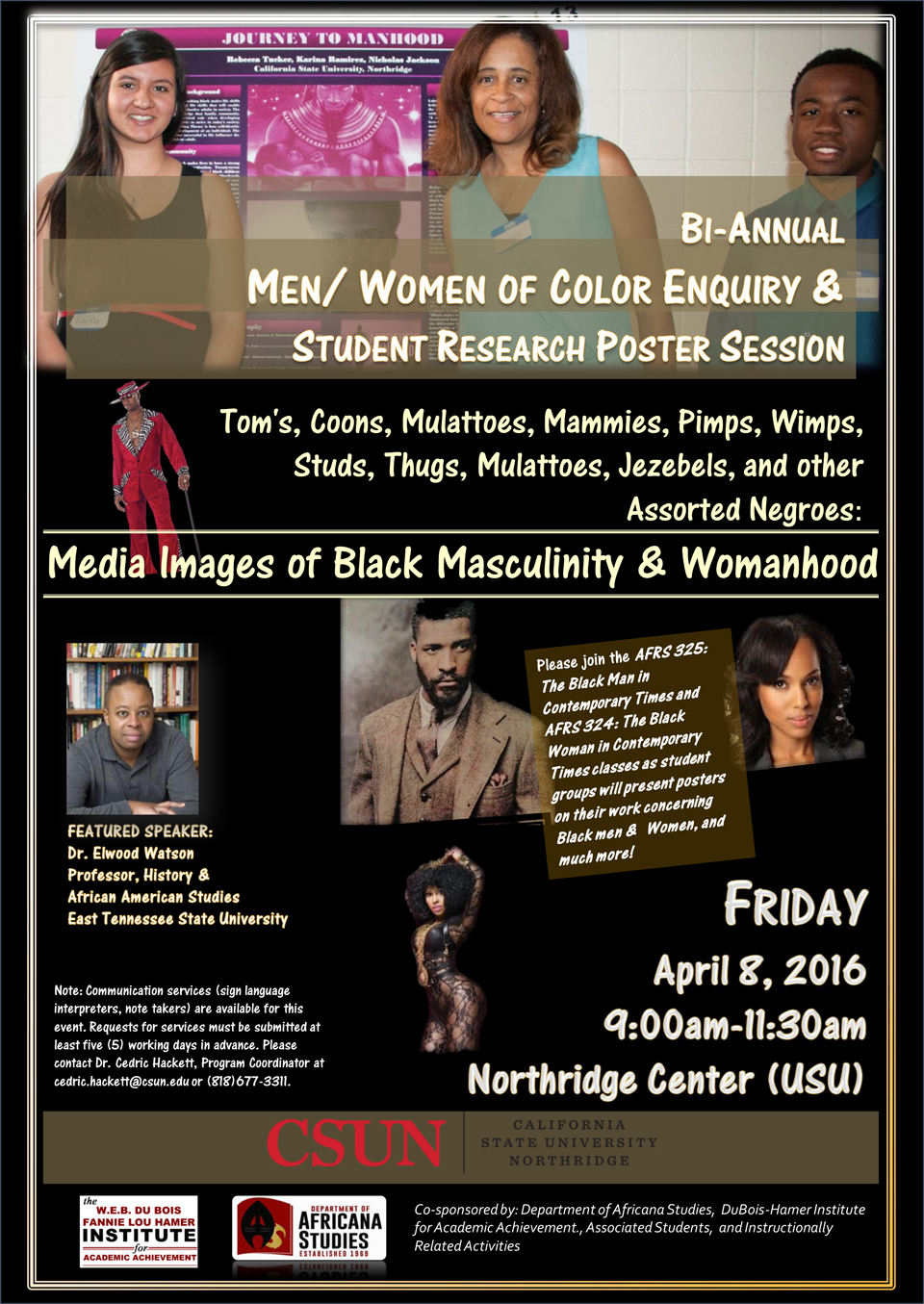Undergraduates to Showcase Research on Media Images of Black Men and Women
Toms, coons, mulattoes, mammies, pimps, wimps, studs, thugs and jezebels — these are some of the stereotypical images of African-Americans in the media that will be explored and deconstructed at the seventh annual Men/Women of Color Enquiry and Student Research Poster Session on Friday, April 8, at California State University, Northridge.
Students will showcase their research into media images of black masculinity and womanhood from 9 to 11:30 a.m. in the Northridge Center at the University Student Union on the east side of the campus, located at 18111 Nordhoff St. in Northridge.
Sponsored by CSUN’s DuBois-Hamer Institute for Academic Achievement, the poster session will display the work of two Africana studies classes, “The Black Man in Contemporary Times” and “The Black Woman in Contemporary Times,” taught respectively by Africana studies professors Cedric Hackett and Marquita Gammage. Students worked in groups to explore research questions on topics such as black men in hip hop, the struggles of black athletes, the psychological processes of gay black men, the relevancy of black feminism in the 21st century and representations of black women’s dating patterns in the media. 
“The poster session is an experience that really enriches the students’ competence level with course content,” said Hackett, director of the institute. “It challenges them to undertake issues of experiences related to black men and women, provide facts to the claims and bring awareness of those issues with an articulation of their findings.”
This year’s theme investigates the assorted images of black women and men present throughout time and paint the entire black community with characteristics that are not true, Hackett said.
Examples of black male tropes are the “coon” and the “tom,” which are black men who went out of their way to serve and please their white masters, and the “thug,” which embodies violence and is represented often in hip hop and rap music.
“These are assigned negative identities that influence the opinion of those who don’t interact with black people,” Hackett said. “So many African-American men have to go through these identities and be aware of them to avoid stereotype threat.”
Gammage, author of the recently published book, “Representations of Black Women in the Media: The Damnation of Black Womanhood,” said she found two main problematic contemporary images of black women in the media — the “jezebel” and the “sapphire” — and sometimes these two stereotypes are combined.
She said in television shows, the jezebel character is hypersexual. In dating patterns, she is portrayed as having trouble securing a male partner because of promiscuous behaviors, even if the character expresses that she values a modest lifestyle. The contradiction results in a lack of success in the dating realm.
In contrast, the sapphire character is a career-centered woman, typically a black woman, who is overly invested in her career at the expense of family and motherhood, lacks a sense of community and emasculates black men in her authoritative position. The sapphire also uses her sexuality to advance herself in the workplace and seduces a white male, often one that is married. This portrayal is exemplified in Olivia Pope, the leading character of the popular ABC television show, “Scandal,” who is one-dimensional, said Gammage.
Gammage pointed to these stereotypes as a reason to look critically at the increase of black women in the media as not wholly positive.
“When we look beyond the surface, we realize that despite the numbers, [the images] represent centuries-old stereotypes of black women,” Gammage said. “These stereotypes have evolved to fit into modern society and are detrimental to black womanhood. They convey the notion that despite a black woman’s wealth, educational attainment, marital or parental status and profession, all of them behave the same as hypersexual jezebels and sapphires. And they continue to delegitimize the talent of black actresses and actors.”
Gammage and Hackett said the poster session not only will spark interesting conversation and explore important issues, it will ultimately help students build their skills and add to their resumes as young academic scholars.
“It’s an outstanding opportunity to present research into a larger intellectual community and engage in a critical component of scholarship,” Gammage said. “It can open the door to presenting research at conferences, publishing their research in student journals and making them competitive for graduate schools.”
The event is free and open to the university and public. However, parking is $6 in the university’s parking structures. For more information, contact cedric.hackett@csun.edu.

 experience
experience